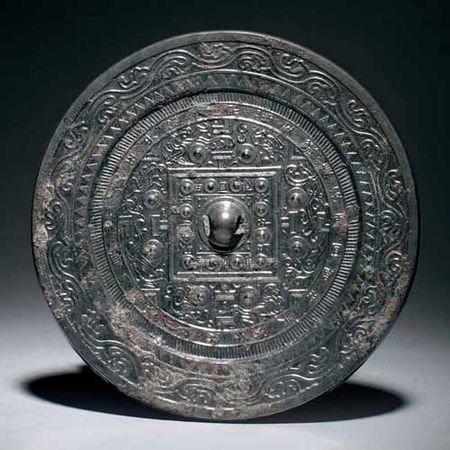Bronze mirror of TLV type. China, Xin dynasty (9–23)
Bronze mirror of TLV type. China, Xin dynasty (9–23)
Diameter : 16.50 cm - Price on application
A bronze mirror of TLV type, the centre with a round knob through which a cord can be threaded. Arranged around this knob, which is centred on a quatrefoil ornament within a square, are the Spirits of the Four Directions – dragon, tiger, bird and turtle – each with their companions: the blue dragon, galloping deer, feathered immortal and upstanding toad, all executed in low-relief and in minute detail. Incorporated in this band are three elements of decoration that resemble the letters T, L and V, and four pairs of small pointed bosses. Within the central square is a band of archaic characters, which together form an inscription, and 12 pointed bosses. Arranged around the main scene are a lengthy inscription and a band of diagonal hatching. On the rim are bands of saw tooth pattern and flowing clouds. The front and back of the mirror are partly covered in an attractive patina, incorporating small areas of ruby and malachite corrosion.
“TLV” mirrors are called thus because of the appearance of symbols resembling the letters T, L and V, which form part of their decorative scheme. This fine example with its crisply cast decoration featuring the Spirits of the Four Directions and their companions shows Han bronze casting at its pinnacle. The high silver content of the material has ensured that the reflective qualities of the mirror remain intact. The twelve-character inscription incorporated in the central square most probably refers to the twelve animals of the zodiac. The present mirror can be dated to the short-lived Xin dynasty; it is practically identical to an example if the Shanghai Museum, which is dated AD 15. Although the Xin dynasty had only one Emperor, Wang Mang, it is still referred to as a ‘dynasty' in Chinese history. Similar mirrors are in the Graham and Carter collections. Another similar example is in the collection of the National Palace Museum in Taipei.
Ben Janssens Oriental Art. 91c Jermyn Street SW1Y 6JB London - United Kingdom. Tel : +44 (0) 20 7976 1888 - Fax number : +44 (0) 20 7976 2588 - info@benjanssens.com - http://www.benjanssens.com

/https%3A%2F%2Fprofilepics.canalblog.com%2Fprofilepics%2F1%2F0%2F100183.jpg)
/https%3A%2F%2Fstorage.canalblog.com%2F03%2F02%2F119589%2F96711876_o.jpg)
/https%3A%2F%2Fstorage.canalblog.com%2F11%2F31%2F119589%2F94773502_o.jpg)
/https%3A%2F%2Fstorage.canalblog.com%2F20%2F83%2F119589%2F94772815_o.jpg)
/https%3A%2F%2Fstorage.canalblog.com%2F26%2F72%2F119589%2F75604929_o.jpg)
/https%3A%2F%2Fstorage.canalblog.com%2F59%2F60%2F119589%2F26458628_o.jpg)



/http%3A%2F%2Fstorage.canalblog.com%2F05%2F64%2F119589%2F128523518_o.jpg)
/http%3A%2F%2Fstorage.canalblog.com%2F78%2F46%2F119589%2F127133605_o.jpg)
/http%3A%2F%2Fstorage.canalblog.com%2F99%2F82%2F119589%2F126892955_o.jpg)
/http%3A%2F%2Fstorage.canalblog.com%2F51%2F84%2F119589%2F122518624_o.jpg)